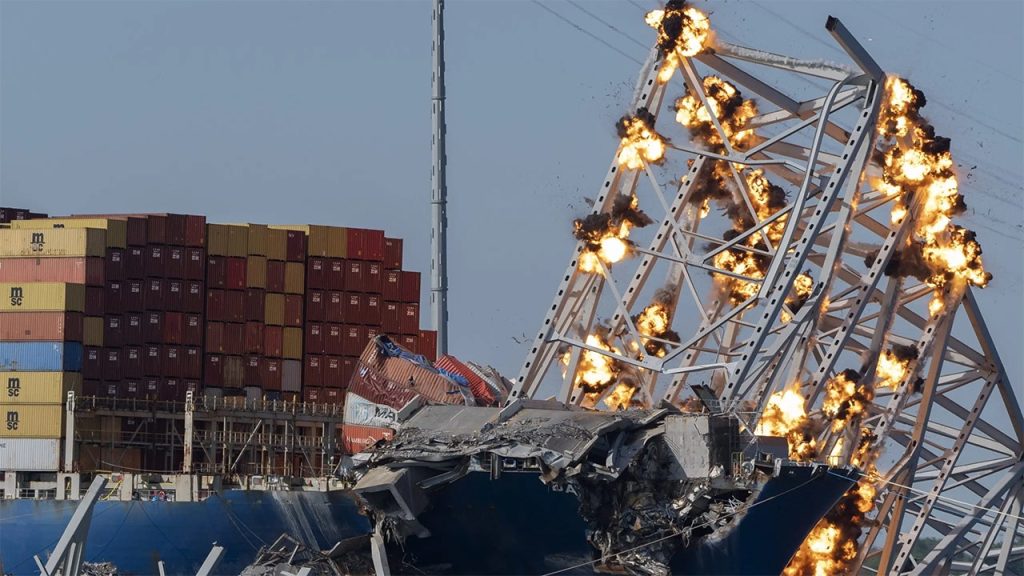Crews used explosives to break apart a large span of the collapsed Francis Scott Key Bridge in Baltimore, Maryland, causing mangled metal to crash into the water below. Video footage captured the detonation of the explosives, with flashes of fire and a loud boom ensuing as the steel truss fell into the Patapsco River, creating a wave that crashed onto the bow of the grounded Dali container ship. The ship has been stuck in the wreckage since March 26, when it lost power and crashed into a column underneath the bridge, leading to the deaths of six construction workers and halting maritime traffic in and out of the busy port. The goal is to free the ship from debris and eventually refloat it, restoring traffic and business in the area.
Officials reported that the explosives detonated as planned, with crews now working to assess the remaining pieces of bridge on the ship’s bow and ensure that nothing underwater is obstructing the process of floating and moving the vessel out of the area. Lieutenant General Scott Spellmon of the U.S. Army Corps of Engineers likened the operation to “peeling back an onion,” emphasizing that they expect to refloat the ship within the next few days. This significant milestone marks progress towards reopening the port and allowing thousands of dockworkers, truckers, and business owners to resume operations.
The 21-member crew of the Dali has been stranded on the ship since the disaster, but they were reported safe without injuries after Monday’s detonation. Col. Estee Pinchasin, Baltimore District Commander for the Army Corps of Engineers, stated that no further explosives are expected to be used in the process. The National Transportation Safety Board and FBI are conducting investigations to determine the cause of the bridge collapse, which occurred after the ship lost power and hit a support column while the crew was unable to control the steering system. The resulting catastrophic event caused the collapse of the bridge, leading to the current situation of the ship being trapped under debris.
The successful detonation of explosives to remove a large section of the collapsed bridge signifies a significant step towards freeing the Dali container ship and restoring traffic through the port in Baltimore. The next phase involves carefully assessing and addressing any remaining obstacles underwater and on the ship’s bow to facilitate its refloating and movement out of the area. Once the ship is freed, it can be relocated to allow traffic to return to normal, providing relief to the dockworkers, truckers, and business owners who have been impacted by the tragic incident. This milestone is a crucial development in the ongoing efforts to recover and resolve the aftermath of the bridge collapse.
Despite the challenging circumstances, the operation to remove the collapsed bridge segment from the ship’s bow proceeded as planned, with no injuries reported among the crew onboard. The crew has been stranded on the vessel since the initial collision, and their safety remains a top priority throughout the recovery process. The coordinated efforts of the U.S. Army Corps of Engineers and other officials involved in the operation are focused on safely and efficiently freeing the ship from the debris and enabling its relocation to restore maritime traffic and business activities in the area. As investigations continue into the cause of the bridge collapse, the community awaits the successful resolution of the situation, allowing for a return to normalcy for all those affected by the tragic event.


